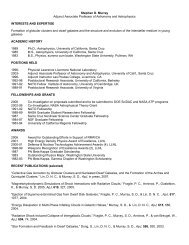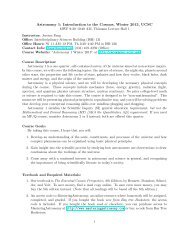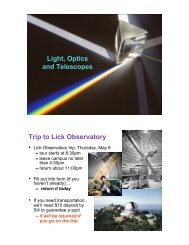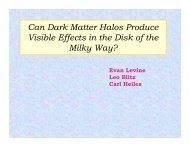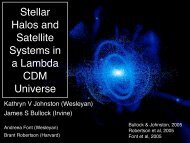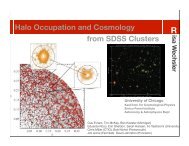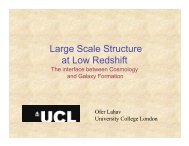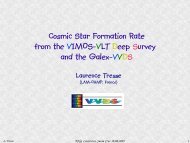UCSC Astronomy & Astrophysics Orientation Guide last update ...
UCSC Astronomy & Astrophysics Orientation Guide last update ...
UCSC Astronomy & Astrophysics Orientation Guide last update ...
You also want an ePaper? Increase the reach of your titles
YUMPU automatically turns print PDFs into web optimized ePapers that Google loves.
ASTR 240C - Galactic and Extragalactic Stellar Systems<br />
Cosmological models. Recombination epoch and thermal history of the<br />
intergalactic medium. Formation of first structures: minihalos, stars, and black<br />
holes. Cosmological reionization and early metal enrichment. Radiative transfer in<br />
a clumpy universe. Quasar absorption systems. Galaxies at high redshifts and<br />
cosmic star formation history. The nature of QSOs and active galaxies.<br />
Extragalactic background radiation. Enrollment restricted to graduate students.<br />
Offered in alternate academic years.<br />
ASTR 257 - Modern Observational Techniques<br />
Astronomical telescopes and detectors. Astronomical observing techniques. The<br />
reduction of observations. Machine shop practice in instrument construction.<br />
Offered in alternate academic years.<br />
ASTR 289 - Special Topics in <strong>Astrophysics</strong><br />
Occasional courses in particular areas of current interest.<br />
ASTR 292 - Seminar (No Credit)<br />
Seminar attended by faculty, graduate students, and upper-division<br />
undergraduate students.<br />
As for the 12 classes: You will be required to take 3 classes in particular. One is<br />
an E & M class on radiation and plasma physics; one is a standard course in<br />
stellar structure & evolution; one is a standard course on galaxies. After that,<br />
you must take at least 2 more classes from the "physics" column, 2 more from<br />
the "stars" column, 2 more from the "galaxies" column, and then take whatever<br />
you like until you have 12. Read more about classes in 3.4<br />
At least one quarter you must be a Teaching Assistant. Typically students do<br />
this early, when they don't necessarily have a regular research advisor for<br />
financial support anyway. (Non-CA residents must do their TA quarter during<br />
their first year, when tuition comes from University sources. After that there<br />
are no funds available to pay out-of-state tuition for TAs.) You become a TA by<br />
signing up to TA for a particular class by consultation with Sissy (the<br />
Department. Manager). There may be some paperwork to fill out and you have<br />
to be on the appropriate payroll. TAs at <strong>UCSC</strong> are unionized. You have the<br />
option of signing up for the union, but all TAs work under union rules, regardless.<br />
Information about the union comes with your TA appointment letter. TAing<br />
involves teaching sections, holding office hours, and grading papers. You may<br />
need to guest lecture for the professor when s/he's out of town.<br />
3.5 Research Project<br />
Ideally during the summer between your 1 st and 2 nd year you will work on a<br />
roughly Master's-thesis-size project. (This is sometimes referred to as the<br />
17




